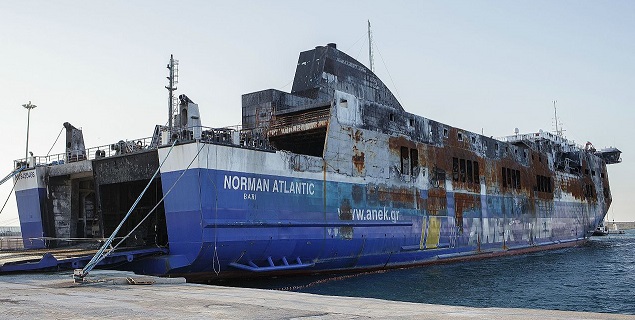Ro-Ro Fires Spark New Safety Guidance
Trade association Interferry has produced operational best practice guidance for fire safety on ro-ro vehicle decks in response to a string of major incidents. Measures to enhance fire prevention, detection and suppression highlight the need for continuous monitoring, rapid response and optimum efficiency of deluge drencher systems.
The guidance is based on input from a questionnaire sent to association members last year following at least seven serious fire incidents on ro-pax ships in Europe since 2010. The two most recent incidents resulted in fatalities and total loss of the ships, prompting the initiative by Interferry’s Operators Policy Committee to identify and publicize a common set of best practice mitigating actions.
The findings have been coordinated by an ad hoc working group and are now being circulated to members. The conclusions will also provide technical and operational feedback for fire-related regulatory discussions at the IMO where Interferry has consultative status.

The best practices identified by members are ranked on a rising scale of importance from 1 to 5, with those scoring 4 or 5 being put forward as the following key recommendations:
• Training and drills should emphasize the importance of a rapid response team proceeding directly to the scene of reported smoke/fire with fire extinguishers and without stopping to dress in firefighting gear
• Training should also emphasize the importance of adopting a defensive firefighting posture after the initial response – the paramount requirement being rapid establishment of containment boundaries on all sides of the fire
• For voyages longer than 20nm, no passengers should be allowed access to any ro-ro deck when the ship is under way without the expressed consent of the master or the designated officer. Any passengers allowed access shall be supervised
• During the voyage all vehicle decks should be continuously monitored - with particular attention to connected reefer units and electric vehicles – via technical equipment such as CCTV, by crew patrols or a combination of remote supervision and crew inspection
• The frequency of flushing existing deluge systems as prescribed in MSC.Circ.1432 9.3.1 should be increased from once to twice per five-year period
• For installations in new ships, the deluge system should be manufactured from non-corrosive materials to prevent blockage
• Operators should ensure that all vessels are fitted with addressable fire detectors, as per the mandatory requirement for new passenger ships since 2010
Among other best practices, the guidance addresses the increased fire hazard posed by reefer units and charging of electric vehicles by recommending that only connectors and cables provided by the ship should be used to supply power, with only qualified ship’s crew carrying out the procedures. Operators are also urged to review the positioning of lifesaving appliances to ensure that their integrity and accessibility are protected from heat, smoke and flames passing through ro-ro deck side openings.
Interferry stresses that the guidance is primarily of an operational nature. On design and technical issues that have emerged, operators have concluded that more research is needed to establish best practices, notably regarding the fluid dynamics effects related to crosswinds over open ro-ro decks.
Regulatory affairs director Johan Roos comments: “Work to enhance fire safety is a never-ending process, and this guidance is a timely further step in that direction. The best practices suggested by our members should carry huge weight because they reflect years of hands-on experience. They share knowledge on what we already know - that prevention is better than cure – and they remind us that, if the worst happens, every second counts in minimizing the effects.”
Further to this initial round of guidance, Interferry plans to issue a more comprehensive version in order to include additional input that is still being provided by members – not only operators but, importantly, also classification societies.
The guidance document is available here.
